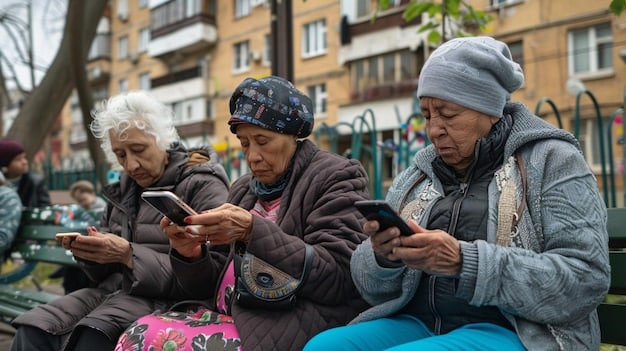Digital Inclusion: Smart City Initiatives for Low-Income Communities

Digital inclusion in low-income communities can be significantly advanced through smart city initiatives by providing access to technology, affordable internet, and digital literacy programs, thereby bridging the digital divide and promoting economic and social equity.
The growing importance of technology in modern life has made digital access a fundamental necessity. Digital inclusion: How smart city initiatives can bridge the digital divide for low-income communities, is therefore essential to ensure that everyone, regardless of their socioeconomic status, can participate fully in the digital age, accessing education, employment opportunities, and essential services.
Understanding the Digital Divide in Low-Income Communities
The digital divide refers to the gap between those who have access to modern information and communication technologies and those who do not. This divide disproportionately affects low-income communities, creating barriers to essential resources and opportunities.
Limited Access to Technology
One of the primary factors contributing to the digital divide is the lack of affordable devices. Many low-income households cannot afford computers, smartphones, or tablets, which are necessary for accessing online services and information.
Affordability of Internet Services
Even when devices are available, the cost of internet service can be prohibitive. High-speed internet is often priced beyond the reach of low-income families, limiting their ability to participate in online education, job searches, and other essential activities.

Closing the digital divide requires a multifaceted approach that addresses both access and affordability. Smart city initiatives are uniquely positioned to tackle these challenges, leveraging technology and strategic partnerships to create a more inclusive digital environment for low-income communities.
Initiatives such as offering subsidized internet access, providing free or low-cost devices, and establishing public computer labs can help to level the playing field and ensure that everyone has the opportunity to thrive in the digital age.
- Affordable internet plans for low-income families.
- Device distribution programs for students and seniors.
- Community technology centers with free computer access.
- Digital literacy training for all age groups.
Therefore, understanding the digital divide and its causes is the first step towards implementing effective solutions to promote digital inclusion in low-income communities.
Smart City Initiatives Promoting Digital Inclusion
Smart city initiatives are designed to use technology and data to improve the quality of life for all residents. When strategically implemented, these initiatives can play a crucial role in bridging the digital divide and promoting digital inclusion.
Public Wi-Fi Access
Providing free public Wi-Fi in parks, community centers, and public transportation hubs can significantly improve digital access for low-income residents. This allows individuals to connect to the internet for job searches, education, and communication without incurring additional costs.
Digital Literacy Programs
Many individuals lack the skills necessary to effectively use digital tools and resources. Offering digital literacy programs can help bridge this gap. These programs can provide training on basic computer skills, internet safety, and the use of online resources for education, healthcare, and employment.
By providing comprehensive digital literacy programs, smart cities can empower residents to take full advantage of the opportunities available in the digital world.
- Basic computer skills training for beginners.
- Online safety workshops to protect against cyber threats.
- Training on using online resources for job searching.
- Educational programs to enhance digital literacy.
Smart City Infrastructure for Connectivity
Investing in robust and reliable internet infrastructure is crucial for ensuring consistent connectivity. This includes expanding broadband access to underserved areas and upgrading existing infrastructure to support high-speed internet services.

Smart city infrastructure can bring digital opportunity to low-income communities by providing connectivity that enables access to a world of information. This connectivity not only helps in bridging the digital divide, but also promotes social equity by ensuring everyone has access to the same digital resources.
By effectively implementing these smart city initiatives, communities can take meaningful strides towards closing the digital divide and ensuring that all residents have the opportunity to participate fully in the digital age.
Successful Smart City Projects Addressing Digital Divide
Several cities have already implemented successful smart city projects that address the digital divide. These projects offer valuable insights and best practices for other communities looking to improve digital inclusion.
Case Study: New York City’s Free Public Wi-Fi
New York City has implemented a comprehensive free public Wi-Fi program, providing internet access in parks, public spaces, and low-income neighborhoods. This initiative has significantly expanded internet access for residents who cannot afford private internet service.
Case Study: Seattle’s Digital Equity Initiative
Seattle’s Digital Equity Initiative focuses on providing affordable internet access, digital literacy training, and access to devices for low-income residents. The city partners with local organizations to offer these services and ensure that all residents have the resources they need to participate in the digital age.
Key Elements of Successful Projects
Successful smart city projects addressing the digital divide share several key elements. These include strong community partnerships, targeted outreach efforts, and ongoing evaluation to ensure that the projects are meeting the needs of the community.
By drawing on these experiences and adopting best practices, cities can create effective programs that bridge the digital divide and promote digital inclusion for all residents.
Successful projects focusing on reducing the digital divide must have:
- A solid foundation of community support.
- Specific goals to ensure outcomes are measurable.
- Ongoing funding for long-term sustainability.
- Dedicated stakeholders who believe in the project’s vision.
Therefore, analyzing successful projects in cities like New York and Seattle gives important lessons on how to effectively bring digital inclusion in urban centers.
Overcoming Challenges in Implementing Digital Inclusion Initiatives
Implementing digital inclusion initiatives in smart cities is not without its challenges. Overcoming these challenges requires careful planning, strong partnerships, and a commitment to addressing the unique needs of low-income communities.
Funding and Sustainability
Securing adequate funding is a primary challenge for many digital inclusion initiatives. Ongoing funding is essential to ensure that programs can be sustained over the long term.
Community Engagement and Trust
Building trust within low-income communities is crucial for the success of digital inclusion initiatives. Many residents may be skeptical of new technologies or uncertain about how to use them. Building trust requires engaging community members in the planning and implementation process and demonstrating a commitment to their needs.
Addressing Digital Literacy Gaps
Even with access to technology and affordable internet, many individuals may lack the digital literacy skills needed to effectively use these resources. Addressing digital literacy gaps requires offering comprehensive training programs that meet the diverse needs of the community.
There are digital literacy programs that focus on:
- Engaging people in community-based learning environments.
- Utilizing the public library system to reach more citizens.
- Creating incentives for early adopters in target communities.
Therefore, overcoming these challenges requires a multifaceted approach that addresses funding, community engagement, and digital literacy gaps. By carefully planning and implementing digital inclusion initiatives, smart cities can create a more equitable digital environment for all residents.
The Role of Public-Private Partnerships
Public-private partnerships (PPPs) can play a crucial role in advancing digital inclusion initiatives. These partnerships bring together the resources and expertise of both the public and private sectors to address the digital divide more effectively.
Leveraging Private Sector Resources
Private sector companies can provide funding, technology, and expertise to support digital inclusion initiatives. Partnerships with internet service providers, technology companies, and philanthropic organizations can help expand access to affordable internet, devices, and digital literacy training.
Creating Sustainable Solutions
PPPs can help create sustainable solutions by aligning the goals of the public and private sectors. By working together, these partnerships can develop innovative models for funding and delivering digital inclusion programs.
PPPs contribute to addressing the digital divide by:
- Bringing more resources to underserved communities.
- Creating economic opportunity through entrepreneurship.
- Fostering local talent in the tech industry.
Therefore, public-private partnerships are essential for creating lasting change and promoting digital inclusion for years to come.
Measuring the Impact of Digital Inclusion
Measuring the impact of digital inclusion initiatives is essential for evaluating their effectiveness and making data-driven decisions. By tracking key metrics, cities can assess whether their programs are achieving their goals and make adjustments as needed.
Key Metrics for Evaluation
Key metrics for evaluating digital inclusion initiatives include the number of residents with internet access, the percentage of households owning a computer or smartphone, and the participation rates in digital literacy programs.
Data-Driven Decision Making
Collecting and analyzing data on digital inclusion metrics allows cities to make informed decisions about program design and implementation. This data can help identify gaps in service and inform strategies for reaching underserved populations.
Effective evaluation strategies include:
- Regular assessments of digital literacy levels in communities.
- Tracking engagement with online resources, job boards, and educational platforms.
- Utilizing demographic data to identify underserved populations.
Therefore, measuring impact and utilizing data drives continued improvement and effectiveness for digital inclusion initiatives.
| Key Aspect | Brief Description |
|---|---|
| 💻 Access | Providing affordable devices and internet access to low-income communities. |
| 📚 Literacy | Offering digital literacy programs to enhance skills and promote effective use. |
| 🤝 Partnerships | Fostering public-private partnerships to leverage resources and expertise. |
| 📊 Measurement | Measuring impact through key metrics for data-driven decision-making. |
Frequently Asked Questions
▼
Digital inclusion refers to ensuring that all individuals and communities, including those from low-income backgrounds, have access to and the ability to use information and communication technologies effectively.
▼
Smart city initiatives involve the use of technology and data to improve the quality of life for residents, enhance urban services, and promote sustainability. These initiatives often include projects focused on connectivity.
▼
Public Wi-Fi provides free internet access in parks, community centers, and public transportation hubs, enabling low-income residents to access essential online resources for education, job searches, and communication.
▼
Digital literacy programs offer training on basic computer skills, internet safety, and the use of online resources for education, healthcare, and employment. They empower individuals to use digital tools effectively.
▼
Public-private partnerships bring together the resources and expertise of both sectors to address the digital divide more effectively. Private companies can provide funding, technology, and expertise to further digital inclusion.
Conclusion
In conclusion, digital inclusion is vital for low-income communities to thrive in today’s digital age. Smart city initiatives provide a pathway to bridge the digital divide by ensuring access to technology, affordable internet, and comprehensive digital literacy programs. Through strategic partnerships and data-driven decision-making, communities can create a more inclusive and equitable digital environment for all residents.





